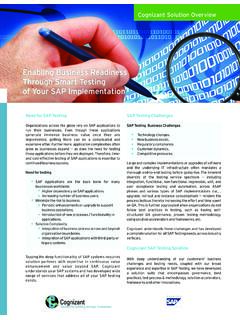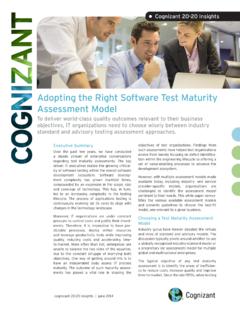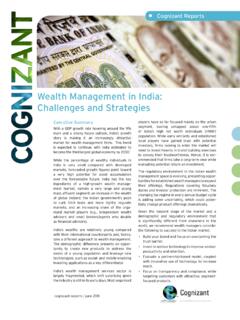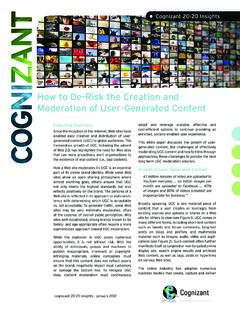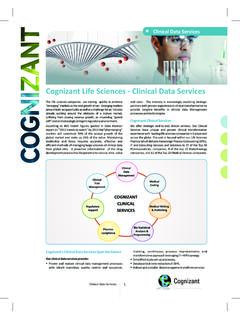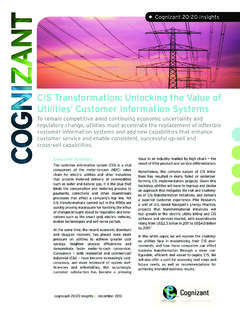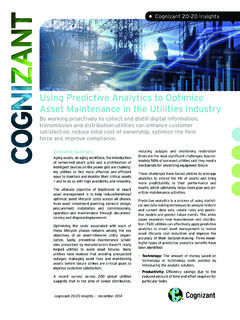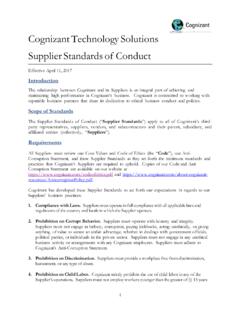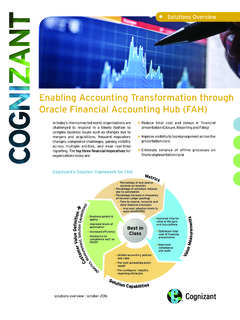Transcription of Business Process Management for Successful Core Banking ...
1 Cognizant 20-20 Insights Business Process Management for Successful Core Banking Implementations To successfully apply BPM when implementing core Banking systems, banks must think through and conquer four major challenges: human processes, systems processes, Business rules engines and Business activity monitoring. Executive Summary Business Drivers for Core Banking The discipline of Business Process Management Core Banking systems are implemented to (BPM) leverages digital tools to create models address one or more of the following Business that enable organizations to optimize key requirements: Business processes.
2 While this approach may be adequate to cover many IT requirements, it is Mergers or acquisitions by a bank. insufficient for the complexities of implement- Need for greater flexibility in an increasingly ing a core Banking system. For core Banking , it competitive market. is therefore necessary to apply a much wider Regulatory changes that cannot be adequately definition of BPM. handled by legacy systems. This white paper examines the Business drivers Enhanced Customer Experience for a Successful core Banking system implementa- Mergers or acquisitions tend to complicate tion.
3 It then addresses four relevant dimensions the bank's Business portfolio, adding a slew of of BPM: products and services many of which overlap Human Processes: The Business processes with one another. The same goes for IT infrastruc- performed by the bank's users, customers and ture, where multiple core- Banking systems collide other human stakeholders. by offering redundant systems and processes. Without a rationalization and harmonization of System Processes: System workflows, system the product portfolio and IT systems, it is difficult interconnections and human/system interac- tions.
4 To achieve any cost efficiencies or a proper inte- gration between the two blended entities. In Business Rule Engines: Business rules that this situation, it is common to choose a to-be . can be automated in a system. core system, which may emerge from selecting Business Activity Monitoring: Visibility of the one of the two legacy systems or creating a new system processes currently in use. advanced system. The success of such an imple- cognizant 20-20 insights | june 2012. mentation can usually be measured in post-merg- of Business Process human processes, system er cost savings in IT and Business operations.
5 Processes, Business rules engines and Business activity monitoring. Many legacy core systems were built in an age when a new product launch could take years Considering the millennial culture and its and inevitably cause Business disruption. With increased reliance on mobile and Web tools, increasing sophistication in the front office, bank banks have to rely heavily on effective core IT departments have supported these operations Banking solutions that include multiple sources of by using a surround strategy where additional accessing customer information including IVRs, systems like customer relationship Management Internet Banking , ATM access, etc.
6 These and systems, loan origination systems, channel other such means enhance the overall customer systems, etc. envelop the core system and require experience and help banks compete in the market minimal changes to application logic. and deliver an enriched experience to customers. With enhanced core Banking solutions, banks With the advent of entrants from outside the typically provide greater analytics. This leads Banking industry, traditional banks are finding banks to better understand their customers, thus it difficult to compete in an environment where helping them provide what the customers want a new product is launched within days rather rather than what the bank has to sell.
7 Than weeks or months. Core systems are being replaced to bring added flexibility. One provider Human Processes of core Banking systems, Temenos, recently Over the last decade, core Banking systems have launched a highly modular architecture in its T24 grown in complexity and features. Today, a core environment that supports rapid deployment of Banking system not only has traditional back- product variants without costly development office functions but also extends to cover inter- Similar features are increasingly available actions between the front office and back office.
8 In other core Banking systems. The success of Core system implementations that continue to these implementations depends on the agility of focus only on back-office functions tend to face Business post-implementation. challenges in integrating front-office systems. Regulators are increasingly requiring banks to Core Banking Beyond Back Office use modern technology to ensure that regulatory As a leader in core Banking , Temenos has compliance requirements are effectively met. attempted to circumvent this challenge by Upgrading legacy systems often leads to pro- enhancing its product catalog and introducing hibitively expensive coding corrections that can the acquire-retain-cross-sell (ARC) framework.
9 Be more effectively resolved using core Banking This framework brings together a suite of front- systems which are built from the ground up to office functionality that can be delivered from its address regulatory compliance issues. Moreover, core Banking system, T24. many compliance mandates are at odds with legacy systems. Examples of new regulations Another leading quadrant player, Oracle Financial that require additional IT investments are: RDR Services, has created the Flexcube Connect compliance in the UK; FATCA compliance in the framework, which allows easy interconnectiv- ; mandatory chip cards in Canada; etc.
10 The ity of legacy front-office systems to Flexcube, cost of implementing these regulatory changes Oracle's core Banking system. This integration in legacy systems can be as expensive as imple- feature is extremely valuable to banks that have menting a new core system that already has already invested in a surround strategy around the technology to support these regulations. their legacy core Banking system. Migrating from The success of such implementations is usually a legacy system to Flexcube can be accomplished measured by a reduced risk of compliance failures.
